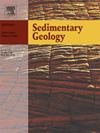Distinct grain-size patterns in sandy turbidites: Implications for identifying the triggers of ancient turbidity currents in lacustrine settings
IF 2.9
2区 地球科学
Q1 GEOLOGY
引用次数: 0
Abstract
Understanding the triggers of turbidity currents from their deposits is crucial to constraining past climate and environmental changes, reconstructing tectonic or seismic activities, and predicting submarine geohazards. However, it is challenging to determine the origin of turbidites when the examined interval cannot be correlated with historically known events or exhibits no lithofacies characteristics. Such work has therefore been performed mainly toward modern turbidites as they are better correlated with recorded events than ancient turbidites. Here we identified two distinct grain-size patterns based on detailed grain-size analysis of the Triassic sandy turbidites in the Ordos Basin. The two patterns vary significantly in sorting and slope value of one-dimensional linear regression equations in the coarsest versus the median grain size (D99–D50) diagram. Poorer sorting with lower slope value (0–1) is interpreted to be river flood-triggered turbidite, whereas better sorting with higher slope value (>1) is interpreted to be slope failure-triggered turbidite. This interpretation is then evaluated by comparison to modern turbidites of known origin. This study suggests that even if the lithofacies are very similar, turbidites with different origin can display distinct grain-size patterns, reflecting fluctuations in source materials, flow capacity and velocity of their original turbidity currents. It also provides a new insight into identifying the triggers of ancient turbidity currents using grain-size data.
砂质浊积岩的不同粒度模式:识别湖泊环境中古代浊积流触发因素的意义
从沉积物中了解浊流的触发因素对于限制过去的气候和环境变化,重建构造或地震活动以及预测海底地质灾害至关重要。然而,当所检查的层段不能与历史上已知的事件相关联或没有显示出岩相特征时,确定浊积岩的起源是具有挑战性的。因此,这种工作主要是针对现代浊积岩进行的,因为它们比古代浊积岩更能与记录的事件相关联。本文通过对鄂尔多斯盆地三叠系砂质浊积岩的详细粒度分析,确定了两种不同的粒度模式。在粗粒度与中位数粒度(D99-D50)图中,这两种模式在一维线性回归方程的分选和斜率值上存在显著差异。较低坡度值(0-1)分选较差解释为河流洪水触发浊积岩,较高坡度值(>1)分选较好解释为边坡破坏触发浊积岩。然后通过与已知来源的现代浊积岩的比较来评价这种解释。研究表明,即使岩相非常相似,不同来源的浊积岩也会表现出不同的粒度格局,这反映了其原始浊积流的物源、流量和流速的波动。它还为利用粒度数据识别古代浑浊流的触发因素提供了新的见解。
本文章由计算机程序翻译,如有差异,请以英文原文为准。
求助全文
约1分钟内获得全文
求助全文
来源期刊

Sedimentary Geology
地学-地质学
CiteScore
5.10
自引率
7.10%
发文量
133
审稿时长
32 days
期刊介绍:
Sedimentary Geology is a journal that rapidly publishes high quality, original research and review papers that cover all aspects of sediments and sedimentary rocks at all spatial and temporal scales. Submitted papers must make a significant contribution to the field of study and must place the research in a broad context, so that it is of interest to the diverse, international readership of the journal. Papers that are largely descriptive in nature, of limited scope or local geographical significance, or based on limited data will not be considered for publication.
 求助内容:
求助内容: 应助结果提醒方式:
应助结果提醒方式:


